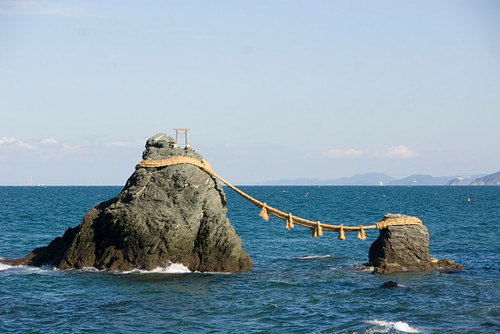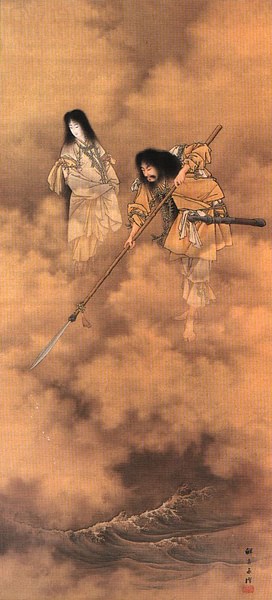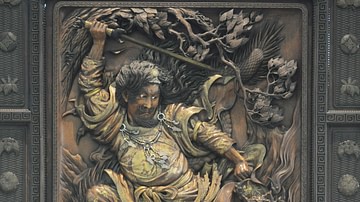
Izanami ('she who invites') and Izanagi ('he who invites') are the primordial gods of the Shinto religion who are believed to have created the islands of Japan and given birth to many of the other Shinto gods or kami.
The myths of Japanese popular religion derive from oral traditions codified for posterity in two books: the Nihon Shoki, published in 720 CE and the Kojiki written by an official of the Empress Gemmyo between 708 and 714 CE. An additional source, the Kogoshui was written in c. 807 CE by Imibe-no-Hironari who collected together oral traditions omitted from the Nihon Shoki and Kojiki.
The Creation of Japan
The islands of Japan are the subject of a particularly colourful creation myth. Standing on the bridge or stairway of heaven (known as Ama-no-hashidate and which connected heaven - Ama - to earth), the two gods Izanami and Izanagi used a jewel encrusted spear to stir the ocean. Withdrawing the spear, salt crystallised into drops on the tip and these fell back into the ocean as islands. In another version, the spear dripped mud from the as yet murky and chaotic seas.
The first island to be created was Onogoro-shima and the gods immediately used the island to build a house and host their wedding ceremony. The ritual involved circling around a pillar (or in some versions the spear) with the two gods moving in opposite directions. However, during this sacred marriage ritual Izanami wrongly spoke first when they passed each other and as a consequence of this impiety their first child was a miscarriage and born an ugly weakling without bones. This was the god Hiruko (later Ebisu) who would become the patron of fishermen and one of the seven gods of good luck. Hiruko was abandoned by his parents and set in a basket for the sea to take it where it would. The second child was the island of Awa but Izanami and Izanagi were still not satisfied with their offspring and they asked their parents the seven invisible gods the reason for their misfortune. Revealing that the reason was their incorrect performance of the marriage ritual, the couple repeated the ceremony, this time making sure Izanagi spoke first.
The couple then continued to create more auspicious offspring, including the eight principal islands of Japan - Awaji, Shikoku, Oki, Tsukushi (Kyushu), Iki, Tsu, Sado, and Oyamato. Also created were a prodigious number of other gods. in fact, more than 800 kami (gods, spirits and natural phenomena) exist in the Shinto pantheon. Other notable children were Oho-wata-tsu-mi (god of the sea), Kuku-no-shi (god of the trees), Oho-yama tsu-mi (god of the mountains) and Kagutsuchi (god of fire), often referred to in hushed tones as Homusubi during ritual prayers.
Izanami's Death & Revenge
The birth of some of the gods came at a certain price though. Izanami was terribly burnt when she gave birth to Kagutsuchi and it is said that many kami were born from her tears as she suffered from her injuries until finally, she died. Revenge was swift though, as Izanagi cut the fire god to pieces with his sword. It is said that many new deities sprang up from each piece of the god.
Izanagi, no doubt unable to live without his beloved wife, rashly followed her down into the underworld or Yomi (also called Ne-no-kuni, land of roots and Soko-no-kuni, the hollow land). Unfortunately, he was unable to rescue Izanami as she had already eaten food in the underworld and so was forbidden from returning to the realm of the living. However, Izanami pleaded with the gods to be made an exception of and made Izanagi promise that he would be patient and not try to see her in her present state. The process of release was long, however, and an impatient Izanagi could wait no more and so attempted to see his beloved. He was in for a shock though, for when he saw her, the body of the goddess was already decomposing. Izanami was more than displeased at her husband breaking his promise and seeing her in such a state but worse, the Eight Thunders and the Ugly Females chased the god out of the underworld. During his retreat, Izanagi stopped the pursuing Thunders by throwing his stick (kunado-no-kami) in their path and it was at this moment that the two gods of roads Chimata-no-kami and Yachimata-hiko were created (together known as Sae-no-kami or Dosojin).
Birth of the Shinto Gods
On finally reaching the outside world, Izanagi blocked the entrance to Yomi with an enormous stone. Fortunate to escape unharmed from such a terrible place of darkness the god had to perform a cleansing ritual in the river Woto to rid himself of the impurities of the underworld. It was during these rituals that various gods were born: Amaterasu, the sun goddess, when he washed his left eye, Tsuki-yomi, the god of the moon, when he washed his right eye, Susanoo (or Take-haya-Susa-no-wo), the storm god, when he washed his nose and Shina-tsu-hiko, the god of wind was born from Izanagi's breath. In addition, when he cast off his tainted clothes in the river a further twelve gods were born from the twelve pieces. In reference to this episode, the practice of harai or cleansing before entering a sacred shrine (jinja) has become an important part of Shinto ritual.
Izanami & Izanagi in Art
In Japanese art the two gods are most often depicted standing on Ama-no-Hashidate stirring the ocean with their spear. The heavenly couple is also famously referenced in the shrine of the wedded rocks of Meotoiwa, on the coast of Futami. Here, two large rocks stand in the sea and are attached by a sacred long rope (shimenawa) of plaited rice straw weighing over a ton, symbolic of the matrimonial bond between the two deities. Atop the larger rock, which represents Izanagi, there is a white gate or torii which marks the site as a sacred shrine. Due to the obvious humidity of the site, the shimenawa is replaced several times a year with great ceremony.






